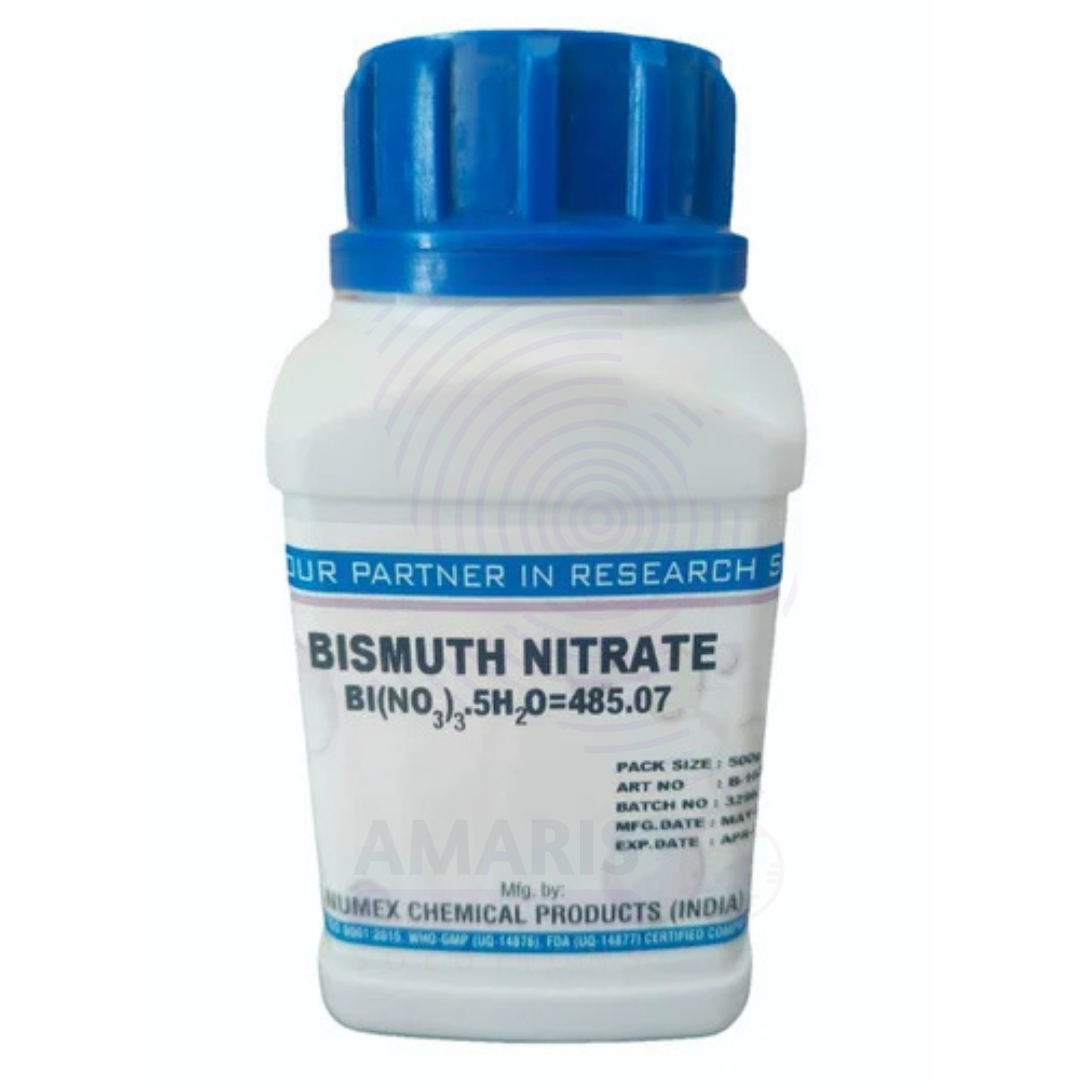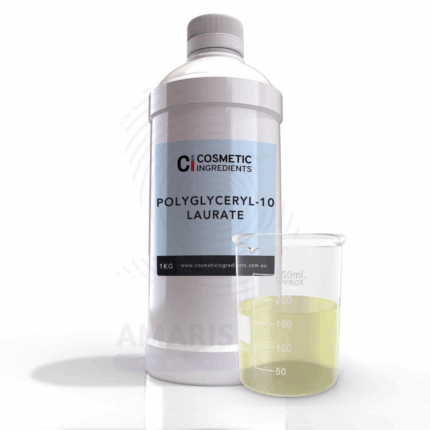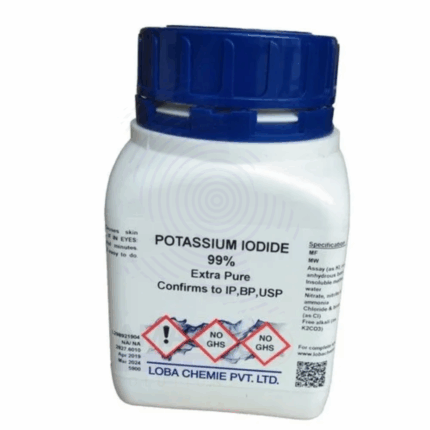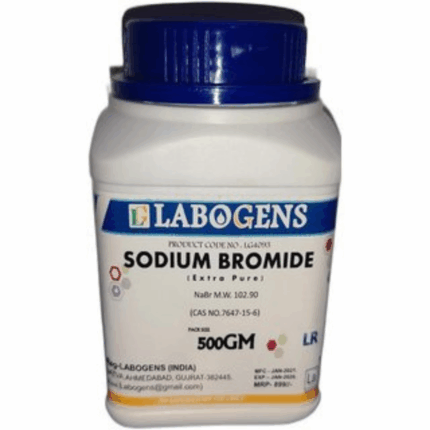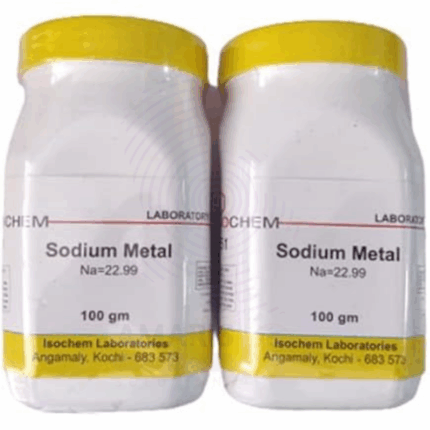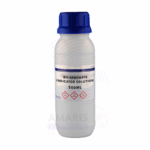
Bicarbonate Indicator Extra Pure
$ 17.00 Original price was: $ 17.00.$ 16.45Current price is: $ 16.45.
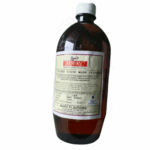
Bitter Masking Pharmaceutical Liquid Flavors Extra Pure
$ 15.00 Original price was: $ 15.00.$ 14.56Current price is: $ 14.56.
Bismuth Nitrate Extra Pure
$ 16.00 Original price was: $ 16.00.$ 15.87Current price is: $ 15.87.
Whatsapp Order
Bismuth Nitrate Extra Pure is a high-purity inorganic compound composed of bismuth and nitrate ions, typically supplied as a crystalline solid or powder. It is widely used as a precursor in chemical synthesis, pharmaceuticals, cosmetics, and industrial applications. Known for its excellent solubility in nitric acid and water, this compound serves as a source of bismuth ions in various chemical reactions and formulations. Its high purity ensures minimal impurities, making it suitable for sensitive applications requiring consistent quality and performance.
Description
Table of Contents
Toggle
Bismuth Nitrate Extra Pure
Primary Uses
- Reagent in Qualitative Inorganic Analysis
- Used for detecting sulfide ions by forming a black bismuth sulfide (Bi₂S₃) precipitate — a classical spot test in qualitative analysis.
- Precursor for Bismuth-Based Compounds
- Serves as a starting material in the synthesis of bismuth oxide, bismuth subnitrate, or bismuth-containing catalysts in research labs.
- Oxidizing Agent in Organic Synthesis
- Occasionally employed in lab-scale oxidative transformations, such as alcohol oxidation or cleavage of C–C bonds.
- Component in Catalysis Studies
- Investigated in heterogeneous catalysis, particularly in the formation of nano-bismuth oxide materials for photocatalytic or environmental applications.
Secondary Uses
- Pigment Chemistry Research
- Used in experiments replicating historic pigment production (e.g., bismuth white) for art conservation or chemical heritage studies.
- Educational Demonstrations
- Demonstrates nitrate decomposition (releasing NOx gases) or precipitation reactions with various anions in advanced chemistry classes.
- Glass & Ceramic Lab Experiments
- Occasionally used in the formulation of specialty glass or ceramic glazes containing bismuth, often at research or prototyping scale.
- Coordination Chemistry Studies
- Forms bismuth-ligand complexes studied in metal-ligand interaction research or crystallography.
Additional information
| PACK SIZE |
100 grams Plastic Tin |
|---|
KEY PRODUCT FEATURES
1. Basic Identification Attributes
- Chemical Name: Bismuth(III) nitrate pentahydrate
- CAS Number: 10035-06-0
- HS Code: 2834.29.90 (Other nitrates, Bismuth compound)
- Molecular Formula: Bi(NO₃)₃·5H₂O
- Synonyms:
- Bismuth trinitrate
- Bismuth nitrate pentahydrate
- Nitric acid, bismuth(3+) salt, pentahydrate
2. Physical & Chemical Properties
- Physical State: Solid (crystalline powder)
- Color & Odor: White to pale yellow; faint nitric acid odor
- Boiling Point: Decomposes before boiling
- Melting Point: ~30 °C (softens/decomposes)
- Density: ~2.83 g/cm³ (solid)
- Solubility:
- Water: Soluble (forms acidic solution)
- Alcohol: Slightly soluble
- pH Level: ~1–2 (1% aqueous solution, acidic)
- Vapor Pressure: Negligible at room temperature
- Flash Point: Not flammable
- Autoignition Temperature: Not applicable
- Viscosity: Not applicable (solid)
3. Safety & Hazard Attributes
- Hazard Class (GHS):
- Oxidizing Solid (Category 3)
- Acute Toxicity – Oral (Category 4)
- Skin Irritation (Category 2)
- Eye Irritation (Category 2A)
- Hazardous to Aquatic Environment (Chronic – Category 3)
- NFPA Ratings:
- Health: 2
- Flammability: 0
- Reactivity: 1
- Exposure Limits:
- No specific OSHA PEL or ACGIH TLV for bismuth nitrate; avoid prolonged exposure
- Reactivity:
- Reacts with organic materials, reducing agents
- Decomposes when heated, releasing toxic NOₓ gases
4. Storage & Handling Attributes
- Storage Conditions:
- Store in a cool, dry, well-ventilated area
- Keep container tightly sealed and away from heat and light
- Incompatible Materials:
- Organic substances
- Reducing agents
- Combustible materials
- Container Type:
- Use chemical-resistant glass or plastic containers
- Shelf Life:
- Stable for at least 2 years if properly stored
- Special Handling Requirements:
- Use gloves and eye protection
- Handle in fume hood to avoid inhalation of acid vapors or NOₓ
5. Regulatory & Compliance Attributes
- Regulatory Status:
- Listed under REACH and TSCA (U.S.)
- Not listed as a controlled substance
- Transportation Restrictions:
- UN Number: UN 1477 (Nitrates, inorganic, n.o.s.)
- Hazard Class: 5.1 (Oxidizer)
- Packing Group: III
- Waste Disposal Method:
- Dispose in accordance with local environmental regulations
- Considered hazardous waste (U.S. EPA)
- Avoid release to water systems
6. Environmental & Health Impact
- Ecotoxicity:
- Harmful to aquatic organisms; avoid environmental release
- Persistence in Environment:
- Bismuth is not highly mobile but accumulates in sediments
- Carcinogenicity/Mutagenicity:
- Not classified as carcinogenic by IARC, ACGIH, or NTP
- Biodegradability:
- Inorganic compound – not biodegradable
SAFETY HANDLING PRECAUTIONS
SAFETY PRECAUTIONS
- Personal Protective Equipment (PPE):
- Wear lab coat, chemical-resistant gloves, and safety goggles.
- Use in a well-ventilated area or under a fume hood to avoid inhalation.
- Handling:
- Handle with care to avoid dust formation and inhalation.
- Avoid contact with skin, eyes, and clothing.
- Do not ingest or inhale.
- Storage:
- Store in a tightly sealed container.
- Keep in a cool, dry, well-ventilated area.
- Protect from light, moisture, and incompatible substances (e.g., strong reducing agents or organics).
- Hygiene Measures:
- Wash hands thoroughly after use.
- Do not eat or drink in chemical handling areas.
FIRST AID MEASURES
- Inhalation:
- Move the person to fresh air immediately.
- If breathing is difficult, provide oxygen.
- Seek medical attention if symptoms develop.
- Skin Contact:
- Rinse thoroughly with soap and water.
- Remove contaminated clothing and seek medical help if irritation develops.
- Eye Contact:
- Rinse cautiously with plenty of water for 15 minutes.
- Seek medical attention if irritation or pain persists.
- Ingestion:
- Rinse mouth thoroughly with water.
- Do not induce vomiting.
- Get immediate medical help.
FIRE FIGHTING MEASURES
- Extinguishing Media:
- Use dry chemical, CO₂, or alcohol-resistant foam.
- Water spray may be used to cool containers, but avoid direct contact with water if the substance is reacting.
- Fire Hazards:
- Oxidizing agents – may enhance combustion of other materials.
- Decomposes at high temperatures producing toxic gases (e.g., nitrogen oxides, bismuth oxides).
- Protective Equipment:
- Wear self-contained breathing apparatus (SCBA) and full firefighting protective gear.
Related products
Bitumen Primer Extra Pure
Bitumen Primer Extra Pure is a high-purity, low-viscosity liquid used in laboratory and industrial research involving adhesion studies, waterproofing technologies, and material compatibility testing. It consists primarily of refined bitumen dissolved in a suitable solvent, allowing it to penetrate and seal porous substrates like concrete, masonry, or metal. In laboratory contexts, it is used to study the behavior of protective coatings, surface treatments, and corrosion resistance. The extra pure grade ensures minimal impurities and uniform consistency, supporting accurate and reproducible test results. Bitumen Primer should be stored in a tightly closed container in a well-ventilated area, away from heat sources, sparks, and open flames
Lead Shot Extra Pure
Lead Shot Extra Pure consists of small, spherical pellets of high-purity lead, typically used in specialized industrial, laboratory, and ballistic applications. In laboratories, it serves as a dense, inert mass ideal for radiation shielding, counterweights, or ball-milling media due to its excellent malleability and high atomic mass. In metallurgy, it can be employed in alloy preparation or as a reducing agent under specific conditions. Its consistent size and purity make it especially useful where uniformity and minimal contamination are critical. Safe handling is essential, as lead is toxic, and prolonged exposure can pose serious health hazards. Proper PPE, ventilation, and disposal methods are mandatory.
Polyglycerol-10-Laurate Extra Pure
$ 19.20
Polyglycerol-10-laurate Extra Pure is a high-purity, non-ionic surfactant and emulsifier composed of ten glycerol units esterified with lauric acid. This versatile compound is especially valued in cosmetic, pharmaceutical, and food-grade applications where ultra-high purity and biocompatibility are critical.
Known for its excellent emulsifying, dispersing, and solubilizing properties, Polyglycerol-10-laurate is widely used in formulations for creams, lotions, and other personal care products, particularly those designed for sensitive skin. In pharmaceuticals, it aids in enhancing bioavailability and improving the stability of active ingredients, while in food applications, it serves as a safe emulsifier and texturizer, often used in dairy and confectionery products.
Potassium Iodide Extra Pure
$ 21.15
Potassium Iodide Extra Pure is a high-purity, white crystalline salt widely recognized for its excellent solubility in water and its versatile applications. In laboratories, it is commonly used as a reagent in iodometric titrations and for preparing iodine solutions. In the medical field, it serves as a key source of iodine and is used for thyroid protection against radioactive iodine exposure. Its antioxidant properties also make it valuable in pharmaceutical formulations and as a stabilizer in various chemical processes. The extra pure grade ensures maximum consistency and reliability for precise experimental and industrial outcomes.
Sodium Bromide Extra Pure
Sodium Bromide Extra Pure is a high-purity, white crystalline inorganic salt used extensively in analytical chemistry, photography, pharmaceutical manufacturing, and water treatment. It serves as a source of bromide ions in various laboratory and industrial applications. Highly soluble in water and chemically stable, sodium bromide is an important specialty reagent with a wide range of uses requiring consistent, high-grade purity. It is non-flammable and safe under recommended handling conditions.
Sodium Metal Extra Pure
$ 17.20
Sodium Metal Extra Pure is a highly reactive, silvery-white metallic solid used extensively in laboratories and industries as a strong reducing agent and reagent in chemical synthesis. It is essential for producing sodium-based compounds and drying solvents. Due to its pyrophoric nature, it must be stored and handled under inert conditions such as mineral oil to prevent spontaneous ignition. It has significant uses in pharmaceuticals, organic synthesis, and metal processing but requires strict safety protocols because of its reactivity with water and air.
Sodium Oxalate Extra Pure
Sodium Oxalate Extra Pure is a high-purity, white crystalline powder widely used as a primary standard in analytical chemistry, particularly for titrations involving potassium permanganate. It serves as a reducing agent and precipitant for metal ions, with additional applications in chemical synthesis and textile processing. The compound requires careful handling due to its irritant properties and should be stored away from oxidizing agents in a dry environment. Sodium Oxalate Extra Pure’s stable nature and moderate solubility make it valuable for precise laboratory applications.
Soluble Starch Powder Extra Pure
Soluble Starch Powder Extra Pure is a fine, white to off-white powder derived from natural starch. It dissolves readily in hot water forming viscous solutions and is widely used as a thickener, binder, and stabilizer in laboratory, pharmaceutical, and food industries. Its Extra Pure grade ensures high purity suitable for analytical and formulation purposes. It is also utilized as an indicator in iodine titrations and in microbiological media preparation. Proper storage in a dry, cool environment and handling with dust protection are recommended to maintain quality and safety.


 Preservatives(food)
Preservatives(food) Flavor Enhancers
Flavor Enhancers Acidulants
Acidulants Sweeteners
Sweeteners Antioxidants
Antioxidants Colorants(food)
Colorants(food) Nutraceutical Ingredients (food)
Nutraceutical Ingredients (food) Nutrient Supplements
Nutrient Supplements Emulsifiers
Emulsifiers
 Collectors
Collectors Dust Suppressants
Dust Suppressants Explosives and Blasting Agents
Explosives and Blasting Agents Flocculants and Coagulants
Flocculants and Coagulants Frothers
Frothers Leaching Agents
Leaching Agents pH Modifiers
pH Modifiers Precious Metal Extraction Agents
Precious Metal Extraction Agents
 Antioxidants(plastic)
Antioxidants(plastic) Colorants (Pigments, Dyes)
Colorants (Pigments, Dyes) Fillers and Reinforcements
Fillers and Reinforcements Flame Retardants
Flame Retardants Monomers
Monomers Plasticizers
Plasticizers Polymerization Initiators
Polymerization Initiators Stabilizers (UV, Heat)
Stabilizers (UV, Heat)
 Antifoaming Agents
Antifoaming Agents Chelating Agents
Chelating Agents Coagulants and Flocculants
Coagulants and Flocculants Corrosion Inhibitors
Corrosion Inhibitors Disinfectants and Biocides
Disinfectants and Biocides Oxidizing Agents
Oxidizing Agents pH Adjusters
pH Adjusters Scale Inhibitors( water)
Scale Inhibitors( water)
 Antioxidants(cosmetic)
Antioxidants(cosmetic) Emollients
Emollients Fragrances and Essential Oils
Fragrances and Essential Oils Humectants
Humectants Preservatives
Preservatives Surfactants(cosmetic)
Surfactants(cosmetic) Thickeners
Thickeners UV Filters
UV Filters
 Fertilizers
Fertilizers Soil Conditioners
Soil Conditioners Plant Growth Regulators
Plant Growth Regulators Animal Feed Additives
Animal Feed Additives Biostimulants
Biostimulants Pesticides (Herbicides, Insecticides, Fungicides)
Pesticides (Herbicides, Insecticides, Fungicides)
 Active Pharmaceutical Ingredients (APIs)
Active Pharmaceutical Ingredients (APIs) Excipients
Excipients Solvents(pharmaceutical)
Solvents(pharmaceutical) Antibiotics
Antibiotics Antiseptics and Disinfectants
Antiseptics and Disinfectants Vaccine Adjuvants
Vaccine Adjuvants Nutraceutical Ingredients (pharmaceutical)
Nutraceutical Ingredients (pharmaceutical) Analgesics & Antipyretics
Analgesics & Antipyretics
 Analytical Reagents
Analytical Reagents Solvents(lab)
Solvents(lab) Chromatography Chemicals
Chromatography Chemicals Spectroscopy Reagents
Spectroscopy Reagents microbiology-and-cell-culture-reagents
microbiology-and-cell-culture-reagents Molecular Biology Reagents
Molecular Biology Reagents Biochemical Reagents
Biochemical Reagents Inorganic and Organic Standards
Inorganic and Organic Standards Laboratory Safety Chemicals
Laboratory Safety Chemicals Specialty Laboratory Chemicals(Special Laboratory Equipment)
Specialty Laboratory Chemicals(Special Laboratory Equipment)
 Demulsifiers
Demulsifiers Hydraulic Fracturing Fluids
Hydraulic Fracturing Fluids Scale Inhibitors(oil)
Scale Inhibitors(oil) Surfactants(oil)
Surfactants(oil) Drilling Fluids
Drilling Fluids
 Dyes and Pigments
Dyes and Pigments Bleaching Agents
Bleaching Agents Softening Agents
Softening Agents Finishing Agents
Finishing Agents Antistatic Agents
Antistatic Agents
 Admixtures
Admixtures Waterproofing Agents
Waterproofing Agents Sealants and Adhesives
Sealants and Adhesives Curing Compounds
Curing Compounds Concrete Repair Chemicals
Concrete Repair Chemicals Anti-Corrosion Coatings
Anti-Corrosion Coatings
 Surfactants(cleaning)
Surfactants(cleaning) Builders
Builders Enzymes
Enzymes Solvents (Cleaning)
Solvents (Cleaning) Fragrances
Fragrances
 Electronic Chemicals
Electronic Chemicals Catalysts
Catalysts Lubricants
Lubricants Photographic Chemicals
Photographic Chemicals Refrigerants
Refrigerants Automotive chemicals
Automotive chemicals Pyrotechnic Chemicals
Pyrotechnic Chemicals
 Biodegradable Surfactants
Biodegradable Surfactants Bio-based Solvents
Bio-based Solvents Renewable Polymers
Renewable Polymers Carbon Capture Chemicals
Carbon Capture Chemicals Wastewater Treatment Chemicals
Wastewater Treatment Chemicals
 Pigments
Pigments Solvents(paint)
Solvents(paint) Specialty Coatings
Specialty Coatings Binders/Resins
Binders/Resins Additives
Additives Driers
Driers Anti-Corrosion Agents
Anti-Corrosion Agents Functional Coatings
Functional Coatings Application-Specific Coatings
Application-Specific Coatings
 Fresh Herbs
Fresh Herbs Ground Spices
Ground Spices Whole Spices
Whole Spices Spice Blends
Spice Blends Dried Herbs
Dried Herbs
 Leavening Agents
Leavening Agents Dough Conditioners
Dough Conditioners Flour Treatments
Flour Treatments Fat Replacers
Fat Replacers Decoratives
Decoratives Preservatives(baking)
Preservatives(baking)
 Plasticizers & Softeners
Plasticizers & Softeners Reinforcing Agents
Reinforcing Agents Adhesion Promoters
Adhesion Promoters Vulcanizing Agents
Vulcanizing Agents Antidegradants
Antidegradants Blowing Agents
Blowing Agents Fillers & Extenders
Fillers & Extenders Accelerators & Retarders
Accelerators & Retarders